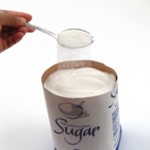 From Halloween to the New Year, most people struggle to control their eating. The average American gains about one pound during the holiday season. Some gain even more. While this is less than the holiday weight gain amounts that get widely reported, most people never lose this excess weight so the pounds accumulate, resulting in obesity or overweight.
From Halloween to the New Year, most people struggle to control their eating. The average American gains about one pound during the holiday season. Some gain even more. While this is less than the holiday weight gain amounts that get widely reported, most people never lose this excess weight so the pounds accumulate, resulting in obesity or overweight.
The 2010 USDA Dietary Guidelines for Americans suggest reducing fat, sodium, and added sugar. Simple substitutions can make your traditional holiday recipes lower in fat and calories without losing the taste. With a little bit of planning and modification, you can create a healthier version of many holiday foods and recipes.
A recipe is actually a chemical formula and each ingredient has a function that results in the taste, texture, and appearance of the end product. It’s important to know what each ingredient does, how it can be changed, and by how much in order to keep the final product as close to the original as possible.
Research has shown that when more fiber is added, when fat and cholesterol is reduced, and/or when less sugar and salt are used, most people either don’t notice much difference between the original and healthier version or they accept the new product. So try out some of the suggestions below to makeover your favorite recipes. Don’t tell anyone you changed it to see if they notice. Contact the UF/IFAS Extension office in your county for more information.
To decrease fat and calories:
| Instead of this: | Try this: |
| Shortening, butter, margarine | Use ¼ less. Replace melted butter or margarine with equal amounts of liquid oil. When baking, replace half of the butter, shortening, or oil with applesauce or prune puree (may reduce baking time by 25%). |
| Full fat sour cream, cottage cheese, Ricotta cheese or cream cheese | Use non-fat or low-fat varieties. Use part-skim Ricotta cheese. |
| Eggs | Use egg whites (usually 2 egg whites for every egg) or use ¼ cup egg substitute. |
To decrease sugar:
| Instead of this: | Try this: |
| Sugar | Reduce sugar by ¼ to ⅓ in baked goods and desserts. Add cinnamon, vanilla, or almond extract for flavoring. Do not remove sugar in yeast breads. Experiment with artificial sweeteners. |
| Syrup | Use pureed fruit, such as no-sugar-added applesauce, or sugar-free syrup |
To decrease sodium:
| Instead of this: | Try this: |
| Salt | Omit salt or reduce salt by ½ in most recipes (except in products with yeast) |
| Seasoning salt or spice mixes with salt | Buy salt-free seasonings. Catsup, chili sauce, chili powder, bouillon cubes, barbecue sauce, soy sauce, meat tenderizers, and Worcestershire sauce are high in sodium. Use herbs, spices, lemon juice, or vinegar instead. |
Source: “Modifying a Recipe to be Healthier” The Ohio State University Extension
- Mental Health at Work: Prioritizing Well-Being in the Workplace - February 5, 2025
- Mental Health: It’s Your Job! - December 6, 2024
- Meet Your FCS Agent – Kendra Hughson - February 21, 2021
